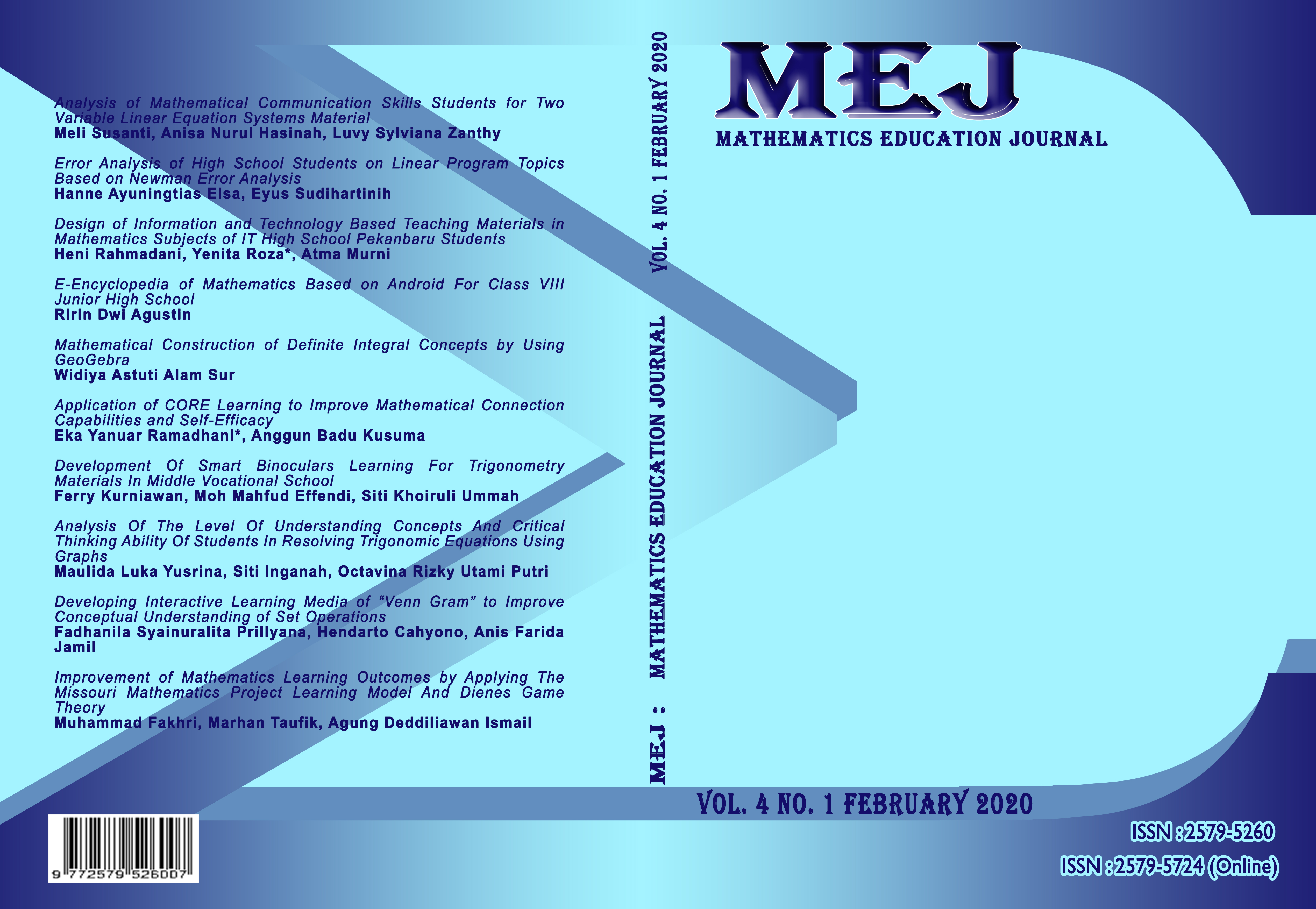Developing Interactive Learning Media of “Venn Gram” to Improve Conceptual Understanding of Set Operations
DOI:
https://doi.org/10.22219/mej.v4i1.11473Keywords:
Media, Venn Gram, Understanding, ConceptsAbstract
This research aimed at discovering the validity and effectiveness of the interactive media of "Venn Gram" to improve the conceptual understanding of the set operations. This research was a development research (research and development). The research subjects were the students of 7th grade who consisted of nine students. The data collection techniques were in the form of a validation questionnaire and test. The subjects were in the form of pre-test and post-test questions which later the answer sheets were used as an increase of students' conceptual understanding before and after using the media. The validation questionnaire results showed that 84% of the media were very valid, 83% of the material was very valid, and 82% of the test questions were very valid. The test results found that seven students experienced an increase in the pre-test and post-test scores. Meanwhile, two other students experienced a decrease. The results of students who had increased showed that the ability of students in understanding the concept of set operations was included in the high criteria before and after using the media. The media of the Venn Gram can be used to improve the conceptual understanding of set operations.Downloads
References
Agustina, L. 2016. Upaya Meningkatkan Kemampuan Pemahaman Konsep dan Pemecahan Masalah Matematika Siswa SMP NEGERI 4 SIPIROK Kelas VII Melalui Pendekatan Matematika Realistik (PMR). Jurnal Eksakta – Volume 1- 2016.
Ali, M. (2009). Pengembangan Media Pembelajaran Interaktif Mata Kuliah Medan Elektromagnetik. Jurnal Edukasi, 5, 11–18.
Darmansyah. 2012. Strategi Pemblajaran Menyenangkan Dengan Humor. Jakarta: Bumi Aksara.
Kamelia, M., Ahmad, & Novitasi, Y. 2017. Pengaruh Strategi Joyful Learning Dengan Teknik Mind Map Terhadap Hasil Belajar Kognitif Peserta Didik Kelas Xi Ipa Sma Negeri 6 Bandar Lampung. Jurnal Tadris Pendidikan Biologi – Volume 8 No. 2 – Desember 2017 – ISSN 2086 5945.
Khairani, M., & Febrinal, D. (2016). Pengembangan Media Pembelajaran dalam Bentuk Macromedia Flash Materi Tabung Untuk SMP Kelas IX. Ipteks Terapan, 10(2),95–102.
Purwanto, Y., & Rizki, S. (2015). Pengembangan Bahan Ajar Berbasis Kontekstual Pada Materi Himpunan Berbantu Video Pembelajaran. Pendidikan Matematika FKIP Univ. Muhammadiyah Metro, 4(1), 67–77.
Rusman. 2011. Model-model Pembelajaran Mengembangkan Profesional Guru. Jakarta: PT.Raja Grafindo.
Wulandari, Nourma Pramestie. 2015. Analisis Pemahaman Siswa Berdasarkan Teori APOS pada Sistem Persamaan Linear Dua Variabel di Kelas X SMA 09 Malang. Malang: Universitas Muhammadiyah Malang
Downloads
Published
Issue
Section
License
Authors who publish with MEJ (Mathematics Education Journal) agree to the following terms:
For all articles published in MEJ, copyright is retained by the authors. Authors give permission to the publisher to announce the work with conditions. When the manuscript is accepted for publication, the authors agree to automatic transfer of the publishing right to the publisher.
Authors retain copyright and grant the journal right of first publication with the work simultaneously licensed under a Creative Commons Attribution-ShareAlike 4.0 International License that allows others to share the work with an acknowledgment of the work's authorship and initial publication in this journal.
Authors are able to enter into separate, additional contractual arrangements for the non-exclusive distribution of the journal's published version of the work (e.g., post it to an institutional repository or publish it in a book), with an acknowledgment of its initial publication in this journal.
Authors are permitted and encouraged to post their work online (e.g., in institutional repositories or on their website) prior to and during the submission process, as it can lead to productive exchanges, as well as earlier and greater citation of published work (See The Effect of Open Access).

This work is licensed under a Creative Commons Attribution-ShareAlike 4.0 International License.










